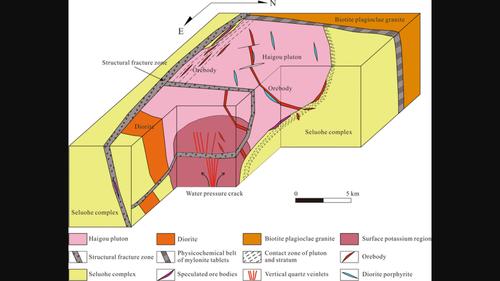Ore‐forming process of the Haigou gold deposit in the eastern Central Asian Orogenic Belt, NE China: Constrains from EPMA and LA‐ICP‐MS analysis of Au‐bearing pyrite
IF 0.8
4区 地球科学
Q3 GEOLOGY
引用次数: 5
Abstract
The Haigou lode deposit, containing 40 t of gold at an average grade of 3.5 g/t, is one of the largest deposits in the Jiapigou gold belt located along the eastern segment of the northern margin of the North China Craton. The deposit comprises 15 gold‐bearing quartz veins hosted in a Carboniferous monzonite–monzogranite stock. Although many studies relating the genesis of this deposit have been carried previously, the understanding of ore‐forming process remains controversial. In this study, we combined field geological mapping with petrography, Electron Probe Micro Analysis (EPMA) and in situ LA‐ICP‐MS analysis of gold‐bearing pyrite to provide new insight into the genesis of the gold deposit. Our results show that Au in the Haigou gold deposit mainly exists in the form of native gold. LA‐ICP‐MS in situ multi‐element mapping shows that Au has a significant positive correlation with Ag, Te, Bi and Pb in Au‐bearing pyrite, indicating that these elements co‐precipitated with Au in pyrite lattice. The ore‐forming fluid existed under medium to low temperature, aiding complexing of the gold with sulfur, chlorine, and tellurium. Decoupling of sulfide and telluride complexes facilitated gold precipitation in the Haigou area. The abundance of lead and nickel tellurides in the Haigou gold deposits with general absence of tellurium in native gold is indicative of expulsion of tellurium through boiling during the process of fluid migration and evolution. Also, coexistence of Bi in native gold indicates that they were at Au–Bi eutectic. The gold‐bearing pyrite is characterized by dispersed magnetite in and around the fractures. The Au–Te–Bi–Pb element anomalies indicate that fluid oxygen fugacity increases while sulfur fugacity decreases with time, resulting in Au precipitation. Our results provide a new theoretical basis for the establishment of metallogenic model and deep prospecting of the Haigou gold deposit.

中亚造山带东部海沟金矿床的成矿过程:EPMA和LA - ICP - MS对含金黄铁矿的制约
海沟金矿床是华北克拉通北缘东段夹皮沟金矿带中规模最大的金矿床之一,含金40 t,平均品位3.5 g/t。该矿床包括15条含金石英脉,赋存于石炭系二长花岗岩-二长花岗岩中。尽管前人对该矿床的成因进行了许多研究,但对成矿过程的认识仍存在争议。在这项研究中,我们将野外地质填图与岩石学、电子探针显微分析(EPMA)和含金黄铁矿的原位LA - ICP - MS分析相结合,为金矿床的成因提供了新的认识。结果表明,金在海沟金矿床中主要以自然金的形式存在。LA - ICP - MS原位多元素图谱显示,Au与含金黄铁矿中Ag、Te、Bi和Pb元素呈显著正相关,表明这些元素与Au在黄铁矿晶格中共析出。成矿流体存在于中低温条件下,有利于金与硫、氯、碲的络合。硫化物与碲化物配合物的解耦作用促进了海沟地区金的沉淀。海沟金矿床中碲含量高,而原生金中普遍不含碲,说明在流体运移演化过程中,碲是通过沸腾排出的。同时,原生金中铋的共存表明它们是金铋共晶。含金黄铁矿以裂隙内及裂隙周围的分散磁铁矿为特征。Au - te - bi - pb元素异常表明,随着时间的推移,流氧逸度增大,硫逸度减小,导致Au析出。研究结果为建立海沟金矿成矿模式及深部找矿提供了新的理论依据。
本文章由计算机程序翻译,如有差异,请以英文原文为准。
求助全文
约1分钟内获得全文
求助全文
来源期刊

Resource Geology
地学-地质学
CiteScore
2.30
自引率
14.30%
发文量
18
审稿时长
12 months
期刊介绍:
Resource Geology is an international journal focusing on economic geology, geochemistry and environmental geology. Its purpose is to contribute to the promotion of earth sciences related to metallic and non-metallic mineral deposits mainly in Asia, Oceania and the Circum-Pacific region, although other parts of the world are also considered.
Launched in 1998 by the Society for Resource Geology, the journal is published quarterly in English, making it more accessible to the international geological community. The journal publishes high quality papers of interest to those engaged in research and exploration of mineral deposits.
 求助内容:
求助内容: 应助结果提醒方式:
应助结果提醒方式:


